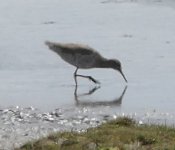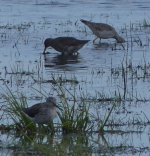Georgebirds
Well-known member

Frampton Marsh, Lincolnshire. Loads of really good sightings, also some confusing ones too far away which I can't wrap my novice-birder head around - any help would be greatly appreciated!




This one was such poor lighting, looked and behaved Redshanky but I just couldn't tell in silhouette whether the legs and bill had the orange colour - Redshank with terrible pics, or something else?




Another wader at the far far reach of my camera zoom, but I did have a look through someone else's scope (they didn't know the ID either) and could see the legs were yellow, the back very greyish, and the neck-into-chest area had speckles below the darker 'bib' colour.




And as for this.... it's...a bird? I have NO idea what I'm looking at here - it was fluffed up and twisting the head back and forth like it was preening, I wonder if this might be TOO bad a photo even for the impressive experts on here who I've seen can pick an ID out of the worst possible shot!


Greenshank in the foreground, but the one in the middle looks darker, has black markings near the legs and under the tail, so could it be a Spotted Redshank changing from winter to summer colour? And the one at the top right corner, too, please - I'm at the point where I've looked at all the pictures in all my books too many times and can't figure anything out - I really do struggle with waders!

Another Redshank with heavy black mottled pattern, I know these photos are not good (taken from deep shade under trees, sorry)


Finally, I saw some Marsh Harriers over the reedbed, and noticed a big variation between one male and another - are they one of those species which varies kind of at random, or is it regional difference? I've never seen one with such pale wings and tail before, and I do see them frequently in my Fens-to-Norfolk birding area.




This one was such poor lighting, looked and behaved Redshanky but I just couldn't tell in silhouette whether the legs and bill had the orange colour - Redshank with terrible pics, or something else?




Another wader at the far far reach of my camera zoom, but I did have a look through someone else's scope (they didn't know the ID either) and could see the legs were yellow, the back very greyish, and the neck-into-chest area had speckles below the darker 'bib' colour.




And as for this.... it's...a bird? I have NO idea what I'm looking at here - it was fluffed up and twisting the head back and forth like it was preening, I wonder if this might be TOO bad a photo even for the impressive experts on here who I've seen can pick an ID out of the worst possible shot!


Greenshank in the foreground, but the one in the middle looks darker, has black markings near the legs and under the tail, so could it be a Spotted Redshank changing from winter to summer colour? And the one at the top right corner, too, please - I'm at the point where I've looked at all the pictures in all my books too many times and can't figure anything out - I really do struggle with waders!

Another Redshank with heavy black mottled pattern, I know these photos are not good (taken from deep shade under trees, sorry)


Finally, I saw some Marsh Harriers over the reedbed, and noticed a big variation between one male and another - are they one of those species which varies kind of at random, or is it regional difference? I've never seen one with such pale wings and tail before, and I do see them frequently in my Fens-to-Norfolk birding area.
Last edited:






